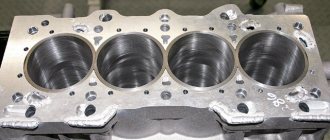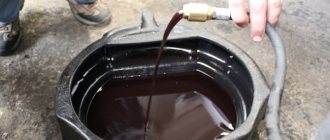Help in choosing engine oil has become in demand ever since there was a plentiful choice. As long as the dealer thinks for you, there is no interest in anything. But when the warranty comes to an end, and the price tag of the official lubricant is terrifying, the most banal idea is used - to find an alternative. And in general, the train of thought is correct, but first we advise you to eliminate the gaps. The questions can be the most unpredictable: what viscosity should the composition be, what additives should it contain and, in the end, should it be synthetic or semi-synthetic?
Where are the roots from?
Engine, transmission, power steering, etc. lubricant is a “base” + additive package. By “base” we mean base oil, by the type of which the origin of the final product is judged: mineral, semi-synthetic or synthetic. In fact, there are not three types of base oils, but five:
- High-sulfur mineral - obtained from heavy fractions of oil together with solvents.
- Low-sulfur mineral water is an ordinary mineral water that has undergone purification. In its pure form, it is a product of heterogeneous molecular composition: the molecules are completely heterogeneous and have different lengths.
- Hydrocracking (HC technology) is a mineral liquid that has undergone hydrotreating. Simply put, this process can be described as the destruction of large molecules in order to create a homogeneous structure and equalize the properties of the lubricant. The trade name of products made using hydrocracking technology is HC synthetics.
- 100% synthetic. In fact, this liquid is a constructor assembled on the basis of polyalphaolefins (PAO). Molecules are synthesized during chemical reactions, the raw material for which is petroleum gas, most often decene. The output is a homogeneous structure with first-class properties.
- Supersynthetic. Advanced oil experts, colleagues from Za Rulem and the author of the revered bmwservice LJ, include in this group everything that is not included in the other four. The calling card of base supersynthetic oil is “esters” or, in other words, esters - the result of the interaction of alcohols and acids. Less commonly, polyalkylene glycol is used as a base. Produced in limited quantities due to the high cost of technology and low demand.
There is no semi-synthetic base as such in its pure form. It is obtained by mixing low-sulfur mineral oil and 100% synthetics. The percentage of PAO component in the mixture is no more than 30%. The admixture of synthetics allows you to stabilize the properties of the lubricant, since in its pure form mineral water has a great dissonance in its characteristics.
Mineral motor oil: advantages and disadvantages
This motor oil is made by distilling fuel oil, that is, from natural petroleum products. During the manufacturing process, various additives are added that significantly improve its performance characteristics. It is believed to ideally withstand changing temperatures during engine operation.
Attention! Mineral motor oil is most often used in cars with low mileage. During break-in, if you use synthetics, the so-called “grinding in” of parts does not occur, so you can lose power in the process. In turn, mineral oil ensures optimal grinding of parts.
Advantages:
- low price;
- the optimal solution for the break-in period.
Flaws:
- instability of additives at high temperatures;
- frequent formation of deposits;
- forms a slight oil film;
- not suitable for severe operating conditions.
A little theory
To a first approximation, the difference between synthetic and semi-synthetic oils is clear - these are different bases. “Polusin” is a modified mineral water, and mineral lubricant is obtained naturally (these are residues from oil after its distillation into gasoline and diesel). Synthetics, on the other hand, are a completely artificial product created during the synthesis of petroleum gas. When comparing performance qualities, it is convenient to use special terminology, which we suggest you familiarize yourself with:
- Viscosity index – characterizes the stability of viscosity properties with temperature changes. Relatively speaking, the higher this number, the lower the viscosity at low temperatures and, as a result, the easier it is to start the engine.
- Figures according to SAE (classification developed by the American Association of Automotive Engineers). Describes the viscosity of the oil. Since the main market share is made up of all-season lubricants, on the box we see two numbers separated by the letter W. For example, 5W-40: 5W is the viscosity category at cold start, 40 is the viscosity class at operating temperature. In fact, the lower the low-temperature viscosity, the easier it is for the engine to crank the crankshaft in cold weather (lower temperature limit 0W: -40, 10W: -30). If the region is too feverish in winter, then various engine oil heaters are used, making this figure as insignificant as on a warm engine. The class, separated by a dash, describes the interval within which the kinematic viscosity can change at operating temperature. For example, for 40 at 100°C it is 12.5-14.5 cSt (centistokes).
- NOACK volatility index. Describes the quality of the fractional composition of the product. The evaluation method is based on calculating the difference between the initial mass and that which remains after boiling at 250°C for a certain time. The more it boils away, the more prone the product is to burning.
- Flash point in a closed crucible. Characterizes the level of safety of the lubricant - the maximum temperature at which the oil can ignite from a spark.
- Oxidation. The time during which the temperature completely reaches the liquid - the base becomes cloudy, additives lose their properties, etc.
Other parameters, such as the alkaline number TBN, acid number TAN, are used to assess the quality and quantity of detergent additives used. Lubricant requirements set by API, ACEA, ILSAC, etc. are aimed at reducing fuel consumption and improving the environment by increasing the life of the catalyst/particulate filter. We will discuss later whether such actions benefit the engine's life, but now is the time to compare synthetic oil with HC synthetics and pure semi-synthetics.
Synthetic oil: all the pros and cons
Synthetic oil is a standard of quality, because it is produced in laboratory conditions. Here is the optimal composition of hydrocarbons, which does not occur in nature. Its high price is perhaps its main drawback, but it can easily cope with harsh operating conditions. This is an ideal solution for a used car.
Attention! If a used car was previously operated on mineral oil, then defects in the CPG can be filled with additives. If you completely flush the system and fill it with synthetic, the engine may “knock.” For used cars, it is better to choose oils with high viscosity to reduce the gap between the cylinders and pistons.
Advantages:
- large operating temperature range;
- withstands high loads;
- reduces friction of parts;
- optimizes fuel consumption;
- Virtually no deposits are formed.
Mineral motor oil is most often used in cars with low mileage.
Flaws:
- there are many fakes on the market;
- high price.
What is the difference between synthetics and semi-synthetics
One of the important performance indicators of a lubricant is viscosity. It indirectly characterizes how the oil will behave in the most highly loaded area - in the area of the piston rings. The film of liquid compounds can be too thin and rupture easily, causing the cylinder walls to wear out quickly. The film of thick lubricants is too thick, which is also not very good: excess can quickly coke the oil scraper rings, depriving them of mobility. In addition, the cross-section of the oil system channels is structurally designed for certain viscosity ranges.
Regarding the viscosity characteristic intervals, it is fair to note some facts. Let's take a canister of 10W-40 and see how the viscosity changes with temperature.
- +100°C – 14 cSt.
- -18°C – 3,500 cSt.
- The crankshaft cranking threshold is 5,000 cSt.
The kinematic characteristic changes more than 200 times.
That is why it is important to become familiar with the concept of “viscosity index,” the definition of which we gave above. So, this same index for synthetics reaches 150, for mineral waters – up to 110, for semi-synthetics – up to 120, for HC synthetics – over 120 to 140. In general, it is not necessary to know these numbers. It is enough to compare products with different types of base oils according to SAE, and absolutely the same trend will emerge by itself:
- Mineral motor oils: 15W-40, 20W-50.
- Semi-synthetic products: mainly 10W-40.
- HC synthetics: 5W-40, 10W-40, 0W-20, 5W-20, 0W-16, 5W-30.
- Synthetics (PAO): 0W-40, 5W-40, 15W-60, 10W-60.
The SAE numbers show us this: the smallest range in the temperature range is for mineral water, the widest is for synthetic lubricants. As for the viscosity number at operating temperature, here, first of all, are the instructions. For the vast majority of car engines, whether naturally aspirated or turbocharged, HC synthetics and synthetics such as 5W-40 and 0W-40 are sufficient. 0W-20 and 0W-16. They are usually prescribed for environmentally friendly versions of cars, such as hybrids, etc., in which every percent of fuel savings counts.
Synthetics 15W-60, 10W-60 are for highly accelerated sports engines, where the stability of the oil film at maximum speed is important. Semi-synthetics are applicable mainly to old cars and domestically produced cars.
There are also differences between synthetic and semi-synthetic bases in oxidation rates and NOACK. Without going into details, synthetics oxidize more slowly, i.e. does not become cloudy for a long time, and is also less prone to burning. However, coke deposits from synthetic waste are highly persistent, making them difficult to remove. Mainly because of this quality, it is not recommended for use in domestic cars, where the gaps in the friction pairs are larger and high consumption of low-viscosity lubricant due to waste is inevitable.
Semi-synthetics oxidize and age faster, are designed for a short service life, are susceptible to waste and have an unstable viscosity during their service life. It would seem that it would be better to replace a semi-synthetic lubricant with a synthetic one and the service life of the engine will instantly extend, but this is not so. Firstly, in older engines the oil system is designed for a certain minimum kinematic viscosity during a cold start. Secondly, oil seals and other seals: due to their insufficient tightness, the engine can eat oil and not smoke.
HC synthetics combine the advantages of synthetic and mineral oils. The group has a dominant position in the mass segment and has an affordable price. Recommended even for domestic cars.
Learn the rules of choosing oil for lawn mowers of different brands
Household appliances with gasoline engines require a responsible approach to maintenance. In order for the tool to enjoy trouble-free operation for a long time, it is necessary to use fuel and oil for the lawn mower in accordance with the technical operating instructions. Two-stroke gasoline engines operate by adding oil to the fuel mixture, while four-stroke engines have a separate reservoir in the fuel tank.
Types of motor oils, their purpose
Motor oil is a special composition consisting of a solvent and additives that reduce friction, create the desired fluidity and prevent thickening when the temperature drops.
According to the method of obtaining the composition there are:
- minerals obtained during the distillation of oil;
- synthetic – by synthesis or processing of natural gas;
- semi-synthetic – improved mineral oil due to the introduction of synthetic components.
For safety reasons, in order not to confuse the products, the oil is colored red, blue or green. The assortment differs in composition; the user needs to buy oil marked: “for garden equipment” 2T, if you need to prepare a mixture for a two-stroke engine, 4T for pouring into the crankcase.
Synthetic and mineral oils have different bases and cannot be mixed. When switching to another type of oil, the system must be thoroughly flushed.
Oil for lawn mowers should be classified as vehicle oils intended for air-cooled engines with a combustion chamber volume of 50-200 cm3. When choosing a product, the important parameter is not the price, but the protective properties for a particular brand of engine. Therefore, first of all, they buy the recommended oil; if it is not available, they select one that is identical in terms of performance.
The alkaline number determines the quality of lawn mower oil. Alkali neutralizes the oxidation process of rubbing materials and slows down the destruction of the surface. When oil becomes oxidized, it loses its protective properties. The normal pH of oil is 8-9 units.
An important indicator is viscosity. Therefore, there are winter, summer and all-season oils. What oil to use for a lawn mower depends on whether the user will work at sub-zero temperatures. Summer oils thicken even with slight cooling. The flash point shows how quickly the oil will burn out of the composition. It is optimal if this indicator is more than 225 C.
The use and importance of oil in a two-stroke engine
Engine operation is associated with friction of moving parts of the cylinder and liner, cams, and hinges. When parts rub, the surface heats up, and when they expand, scuffing occurs. If in the gap between the mating parts there is a composition in the required proportion of oil and gasoline for the lawn mower, a number of problems are eliminated:
- parts in the engine operate with reduced friction and heat up less;
- lubricant in the gaps prevents corrosion of parts during long-term storage and washes out particles produced by friction;
- engine service life is extended.
The appearance of additional properties is facilitated by the additives used, contained in the oil in an amount of 5-15%. It is the additives that create the anti-corrosion, anti-wear and frost-resistant properties of oils.
An incorrect oil composition can destroy the engine, forming carbon deposits in the cylinders, leading to coking and rapid engine wear.
It is important to know how much oil you need to add to the gasoline for your lawn mower. First of all, you should study the instructions and follow the recommended proportions. Using a composition that takes into account the model and configuration of the engine, climatic conditions and load will extend the life of the lawn mower. Experienced users advise that when purchasing a tool, immediately buy the recommended oil in reserve.
Requirements for the fuel mixture for a two-stroke engine
The difference between a two-stroke engine is its increased power compared to a four-stroke engine. The combustible mixture for it is prepared in a certain ratio of gasoline and special oil. The optimal ratio of oil and gasoline for a lawn mower is written in the instructions. The recommended proportions must be followed exactly. When adding additives, the manufacturer took into account the type of engine. Therefore, mixing different oils is prohibited.
When using mineral oils, mixing occurs in proportions of 1:25, 1:30, 1:35. For synthetic oils, a ratio of 1:50 or 1:80 is used. This means that in each of the proposed mixtures the required amount of oil is dissolved in the volume of gasoline. You can mix gasoline with lawn mower oil like water and syrup. It is necessary to pour gasoline, add the exact amount of oil and shake the mixture. It is advisable to use fresh solution for work. If stored for more than 2 weeks, the composition changes, and the oil film will cause carburetor malfunctions.
PET bottles must not be used for diluting and storing flammable mixtures. Gasoline destroys plastic, the polymer dissolves in the combustible mixture and further deteriorates the quality of the fuel, creating the danger of stray currents.
Choosing the right oil for lawn mowers
Two-stroke engines are fueled with a mixture of unleaded gasoline and oil marked 2T. In this case, you need to use the recommended AI-92 gasoline. If you use a brand with a higher octane number, the flash and combustion temperature will be higher, and the valves will burn out prematurely. The same applies to butter. The recommended composition is not the most expensive. But using another brand is unacceptable. The viscosity will change, this will lead to insufficient lubrication of conventional products made without high-precision lapping.
If oil is added in excess, incomplete combustion will lead to the formation of soot and excessive exhaust into the atmosphere. A rich mixture is harmful to the engine. For a four-stroke engine, oil is poured separately from gasoline. It washes the components, cools them, and reduces friction. During operation, the oil becomes contaminated and must be replaced after 50 working hours. What kind of oil to pour into the lawn mower is indicated in the passport. The composition must be marked 4T with a viscosity of 10W40.
The best oil for any engine is the recommended one. However, Shel Helix Ultra oil is world famous. The company has been developing new technology for producing synthetic oil from natural gas for 40 years. Pureplus technology made it possible to obtain an improved base oil composition. On its basis, with the addition of the necessary additives, leading manufacturers obtain recommended oils for their equipment.
The choice of oil primarily depends on the manufacturer’s recommendations. Thus, only branded oil is used for Stihl lawn mowers. The same oil is suitable for the Vityaz brand, since the engines are of the same brand. There is an opinion among experts that oil from any manufacturer intended for one type of equipment is suitable for use on all brands. But if possible, it is better to use the recommended one.
You should have a supply of oil as needed for one season. A product that has stood for a long time loses its properties. Packages from 0.1 to 5 liters are available for sale.
The path of the oil recommended for the Husqvarna lawn mower has been studied. The company does not have its own production, only a bottling shop. A product purchased in bulk is bottled into small containers, labeled and supplied to the retail chain. It is possible that exclusive additives for Husqvarna were added to the oil at the manufacturing stage.
The use of oil, according to the operating instructions for the brush cutter, is mandatory. The equipment cannot operate on pure gasoline.
Oil dosage for lawn mowers - video
dom-krolika.ru
What about additives?
The task of additives is to reduce the rate of oxidation, impart detergency to the lubricant and, ultimately, increase the antifriction characteristics of the composition as a whole. Initially, their concentration was calculated with an eye to the maximum. As strict environmental standards developed, the additive package began to be cut down in order to increase the service life of the catalyst/particulate filter.
The main additives are:
- Phosphorus and zinc are anti-wear.
- Calcium and magnesium are detergents.
- Molybdenum and boron are anti-friction.
Continuing the words about automaker approvals and, in a broader sense, API and ACEA approvals, we can say the following: industrial giants are ready to save on additives such as phosphorus and reduce the concentration of ash, which is a natural detergent, for the sake of environmental standards. In a practical sense, this trend is not very pleasant: the insides of the engine are poorly washed, which is why standing idle in traffic jams contributes to the coking of deposits on the parts, and complete oxidation occurs much faster. What is noteworthy is that if the engine does not consume oil, then such measures are useless. When lubricant consumption is observed, even without any measures this will quickly finish off the catalyst.








